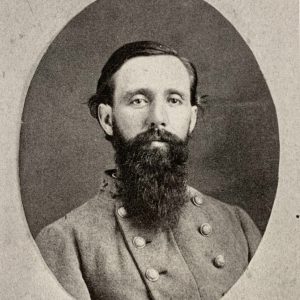calsfoundation@cals.org
William H. Brooks (1838–1869)
William H. Brooks was a Confederate colonel who led both infantry and cavalry troops in some of the fiercest battles fought in Arkansas during the Civil War.
William H. Brooks was born in Detroit, Michigan, on January 28, 1838, the son of a U.S. army officer. He moved to Monticello (Drew County) in 1859 but soon moved to Fayetteville (Washington County), where he practiced law.
When the Civil War began in 1861, he enlisted as the captain of Company E, First Arkansas Cavalry Battalion, later becoming major, after which the unit also became known as Brooks’ Arkansas Cavalry Battalion. The First Arkansas was part of Brigadier General James M. McIntosh’s Cavalry Brigade in the March 7–8, 1862, Battle of Pea Ridge, losing eleven killed and thirty wounded. The battalion went east of the Mississippi River with the rest of Major General Earl Van Dorn’s Army of the West after the battle. Brooks resigned from the unit after he was not elected lieutenant colonel when the First Arkansas was reorganized in 1862.
Returning to Arkansas, Brooks was commissioned as the colonel of the Thirty-fourth Arkansas Infantry Regiment on August 16, 1862. The regiment was part of Brigadier General James F. Fagan’s brigade and suffered heavy casualties in the fierce back-and-forth fighting around the Borden House during the December 7, 1862, Battle of Prairie Grove. The Thirty-fourth was on the periphery of Fagan’s brigade in the July 4, 1863, Battle of Helena and sustained light losses compared to other regiments in the fight.
Brooks apparently detached from the Thirty-fourth Arkansas in October 1863 and led cavalry units under Erasmus Stirman and Robert C. Newton on a raid into northwestern Arkansas, where they were joined by William “Buck” Brown’s band of irregular troops. On October 15, they attacked a wagon train of the First Arkansas Cavalry (US) but were repulsed when Brooks failed to press the attack, leading a young bushwhacker to write “Col Brooks was a gallant & brave Officer, which he demonstrated on several occasions, when in command of an Infantry Reg. But like most Infantry Officers lacked the dash & enthusiasm necessary for a Cavalry Leader.” The Arkansas troops linked up after the fight with Brigadier General Joseph O. Shelby’s brigade as it returned from a raid into Missouri and fell back below the Arkansas River.
Fagan recommended Brooks for promotion to brigadier general on March 18, 1864, but Confederate authorities did not act on the nomination.
Brooks rejoined the Thirty-fourth Arkansas, which next saw combat in the April 30, 1864, Engagement at Jenkins’ Ferry. Brigadier General Alexander Hawthorn wrote that Brooks “led his men into the very thickest of the fight and remained in the front of his Regt cheering and encouraging his men until his horse was shot from under him and he himself [was] severely wounded.”
After recovering from his wounds and perhaps reflecting on his service during the previous October, Brooks requested permission on May 27, 1864, to raise a regiment of cavalry in Benton, Washington, Madison, Johnson, Franklin, Marion, Newton, Carroll, Pope, Searcy, and Van Buren counties by gathering such bands as those led by Pete Mankins, Buck Brown, and James Ingram, writing that “there are now in that section of the state, under various organizations, over one thousand armed men….I confidently believe that an effective command of twelve hundred men can be concentrated in a short time.”
Brooks led troops in the operations around Fayetteville between October 25 and November 4, 1864, helping to keep the First Arkansas Cavalry (US) bottled up as Major General Sterling Price’s shattered army retreated through the area after his disastrous Missouri raid. He also commanded the last substantial offensive operation against Union troops along the Arkansas River, fighting the January 14, 1865, Action at Dardanelle and at Ivey’s Ford on January 17, 1865, where he caused significant damage on Union shipping.
After the war ended, Brooks went back to practicing law in Fayetteville and served in the Arkansas General Assembly in 1866 and 1867. He later moved to Fort Smith (Sebastian County), where he was “engaged in furnishing supplies to government contractors.” He died of consumption (tuberculosis) there on March 19, 1869, and is buried in Oak Cemetery.
For additional information:
Allardice, Bruce S. Confederate Colonels: A Biographical Register. Columbia: University of Missouri Press, 2008.
Christ, Mark K. Civil War Arkansas 1863: The Battle for a State. Norman: University of Oklahoma Press, 2010.
———. “‘It was simply a fight to the death’: Civil War Record (1861–1865) of J. Montgomery Wilson.” Arkansas Historical Quarterly 80 (Spring 2021): 75–81, 100–101.
“Col. William H. Brooks.” Fayetteville Weekly Democrat, March 27, 1869, p. 3.
“Death of Col. Wm. H. Brooks.” Arkansas Gazette, March 24, 1869, p. 2.
Shea, William L. Fields of Blood: The Prairie Grove Campaign. Chapel Hill: University of North Carolina Press, 2009.
Shea, William L., and Earl J. Hess. Pea Ridge: Civil War Campaign in the West. Chapel Hill: University of North Carolina Press, 1992.
The War of the Rebellion: A Compilation of the Official Records of the Union and Confederate Armies, Series I, Vol. 22, part 1, pp. 660–661. Washington DC: Government Printing Office, 1888.
“William H. Brooks.” Find-A-Grave. https://www.findagrave.com/memorial/41960495/william-h-brooks (accessed May 27, 2023).
Mark K. Christ
Central Arkansas Library System








Comments
No comments on this entry yet.